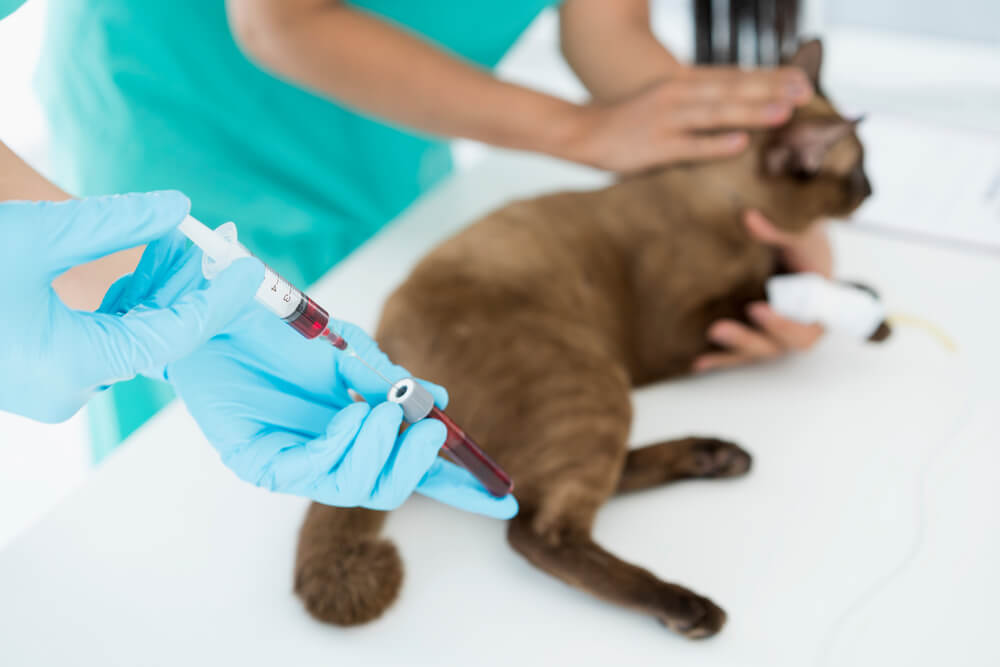Blood work is a valuable tool that assists your veterinarian in disease diagnosis and early detection. However, pet owners may wonder if it really is necessary—especially when their pet is healthy or the results are normal or inconclusive. But what blood work doesn’t show can be as helpful and revealing as a “High” or “Low” result. To illustrate the breadth of information that can be gleaned from one simple blood sample, here’s a guide to blood work basics from Neighborhood Vets Mobile Care.
Why blood work is recommended for healthy pets
Dogs and cats instinctively hide pain and weakness, so although your pet may look healthy, they could be suffering from a hidden illness. Annual blood work during your pet’s wellness visit can help your veterinarian detect subtle changes that could indicate underlying disease. When these changes are noted months or years before visible illness, intervention or treatment is more successful, less invasive, and less expensive.
Normal blood work can be equally valuable because it provides a baseline for your pet, which will be a helpful reference if they become sick later on.
How can blood work help your sick pet
When your pet is sick, blood work can help in their diagnosis. Whether blood work results point directly to a cause—such as high kidney values indicating renal failure—or rule out suspected conditions, the tests help your veterinarian determine the root of your pet’s ailment and build a safe, targeted, and effective treatment plan.
What’s included in your pet’s blood work panel
Although specialized testing may be required in some circumstances, the standard blood work panel includes a complete blood count and a general chemistry profile. These two tests together analyze the cellular and liquid components of your pet’s blood. Our mobile laboratory allows us to obtain results within 15 minutes of sample collection.
Your pet’s complete blood count
The complete blood count, or CBC, is a small assembly of values and measurements that assess blood’s cellular portion. The CBC tells a lot about your pet’s health, including:
- Hydration — When pets are dehydrated, the liquid portion of their blood is reduced and can make their red blood cells (RBCs) appear concentrated.
- Anemia — Low RBCs can indicate blood loss, cell destruction, or a failure to produce RBCs.
- Infection — White blood cells (WBCs) are a large part of your pet’s immune system. An increase in WBCs—which include neutrophils, lymphocytes, eosinophils, basophils, and monocytes—can suggest an infection as the cells respond to a bacterial threat.
- Inflammation — Specific white blood cells also may respond and multiply to fight inflammation.
- Cancer — Some blood cancers—including lymphoma and leukemia—can be identified on the CBC, although additional testing is necessary for diagnosis.
Your pet’s general chemistry profile
The general chemistry profile evaluates your pet’s organ function and can indicate injury, disease, and dysfunction. The chemistry is commonly relied upon before surgery to ensure your pet’s liver and kidneys can metabolize and filter out anesthetic medications.
While the general chemistry measures many specific values, the main assessment areas include:
- Kidneys — Your pet’s kidneys perform many important duties, including purification and filtration of blood. When kidney health is compromised, toxins accumulate in the body and affect internal equilibrium. The general chemistry profile looks at these values:
- Blood urea nitrogen (BUN)
- Creatinine (CREA)
- Liver — The liver is essential for blood filtration as well, but it also is responsible for making essential proteins and breaking down (i.e., metabolizing) specific food components to be used in other areas of the body. Liver health is assessed with the following values:
- Liver enzymes — Alanine aminotransferase (ALT), alkaline phosphatase (ALP), and gamma glutamyl transferase (GGT).
- Albumin — Albumin is a protein made by the liver and is responsible for keeping blood and fluid inside the vessels. When ALB values change, it can indicate a range of problems, including dehydration, liver failure, cancer, inflammatory bowel disease, pancreatitis, and many other serious conditions.
- Bilirubin — This byproduct of RBC breakdown passes through the liver. Elevations can suggest liver dysfunction and may be visible as jaundice (i.e., yellow skin, eyes, or gums).
- Pancreas — The pancreas secretes digestive enzymes to break food into usable components. If pancreatic enzymes—amylase (AML) and lipase (LIPA)—escape the pancreas through inflammation or injury, pets can feel intense pain and experience acute (i.e., sudden, severe) or chronic (i.e., slow and subtle) illness.
- Electrolytes — Electrolytes must be maintained in a careful balance to ensure proper internal function, pH balance, and hydration. Significant electrolytes include:
- Sodium (Na+)
- Potassium (K+)
- Chloride (Cl)
Change isn’t always bad when it comes to your pet’s results

While a red or blue colored value on your pet’s results may seem alarming, it’s important to remember two things:
- Blood work is a snapshot of a moment in time, but your pet’s internal health is dynamic and always changing.
- Blood work must be viewed as a whole as well as in part—meaning that while each value is significant, all of them must be evaluated within the big picture, because many values are interrelated.
If you’re worried about understanding your pet’s blood work, don’t. Dr. Nieman will review your pet’s results with you and explain any significant findings or concerns. And because you’re familiar with the basics of blood work, you’ll have a better understanding of your pet’s health. Schedule your pet’s next appointment with Neighborhood Vets Mobile Care.

